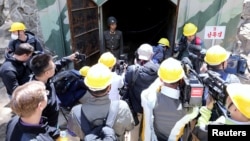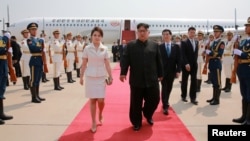The U.S. insistence on the complete denuclearization of North Korea could work against America’s interests as political pressure mounts to make rapid progress, analysts say.
“It actually creates incredible inverse incentives to reduce the size and estimation of the problem,” said Rebecca Hersman, the director of the Project on Nuclear Issues and an international security adviser to the Center for Strategic and International Studies in Washington, during a Singapore summit assessment forum this week.
Vague commitment
North Korean leader Kim Jong Un reaffirmed his commitment to the complete denuclearization of the Korean Peninsula when he met with U.S. President Donald Trump at the recent Singapore summit.
The United States, South Korea and Japan all interpret Kim’s commitment to mean the complete, verifiable, irreversible dismantlement (CVID) of the North’s nuclear arsenal.
“Complete denuclearization is the goal. I think the V and the I, the verifiable and irreversible, is the methodology getting to that goal. So the task now is how to spell out that methodology to reach that goal,” said South Korean Foreign Minister Kang, Kyung-wha on Wednesday.
The United States and its allies also vowed to keep international sanctions against North Korea in place until “significant progress” is made toward reaching the denuclearization goal.
In contrast Pyongyang wants a step-by-step approach linking concessions to incremental progress.
Political pressure
The CVID approach may seem comprehensive but political pressure could persuade the United States to define success in a limited way to gain a dramatic win, perhaps by dismantling a limited number of declared nuclear weapons and sites, but not accounting for undisclosed capabilities.
“If North Korea gives up the missile warheads or the ICBMs in the earlier stages, then I believe that U.N. Security Council will be able to adopt a resolution to relieve the sanctions or even partly abolish them,” said Moon Chung-in, a special adviser to South Korean President Moon Jae-in.
The Trump administration is pressing for rapid progress that could help his Republican Party in the November midterm elections or help his own re-election bid in 2020.
The Kim government also wants a resolution to soon ease the harsh economic sanctions that block 90 percent of the country’s trade.
Take it step by step
A step-by-step process might provide incremental incentives for less dramatic results, but could also be used to hold North Korea accountable until its compliance can be assured.
“I prefer to look at it and say, ‘I don’t trust North Korea.’ Step-by-step, I will want to reduce that risk. I want to reduce what they do to me and our allies. And I am never going to believe it until I can believe the fundamental political situation and the nature of the regime has changed,” said Hersman, the CSIS adviser who also worked on countering weapons of mass destruction for the State Department during the administration of President Barack Obama.
U.S. Secretary of State Mike Pompeo plans to meet with North Korean officials “at the earliest possible date “to implement the outcome of the recent leaders’ summit,” according to the State Department on Thursday.
Many analysts expect the next round of talks to produce a detailed plan to enact the vague declaration of intent made at the summit, beginning with what weapons systems, materials, technology and development facilities are to be targeted for dismantlement.
Warheads, weapons labs
North Korea is estimated to have between 20 and 60 nuclear warheads, numerous ballistic missiles, including intercontinental ballistic missiles (ICBM) that can potentially strike the U.S. mainland, and 40 to 100 clandestine weapons labs and facilities, according a RAND Corporation report.
President Trump said on Thursday North Korea was blowing up four of its big test sites and “total denuclearization” has already started taking place.
However U.S. Defense Secretary Jim Mattis said he was “not aware” of any North Korea denuclearization measures at this time, and the U.S.-based North Korea monitoring group 38 North recently said there had been no sign of any activity toward dismantling any other missile test site in North Korea.
Lee Yoon-jee in Seoul contributed to this report.










